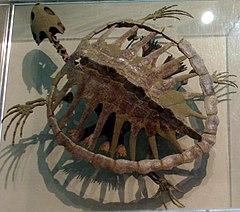Smoky Hill Chalk
| Smoky Hill Chalk | |
|---|---|
| Stratigraphic range: Late Coniacian-Early Campanian | |
 This fossil of Prionochelys, an extinct marine turtle, is held in the Smithsonian's National Museum of Natural History. Many Smoky Hill Chalk vertebrate fossils have found their ways to natural history museums all over the world. | |
| Type | Geological formation |
| Unit of | Niobrara Formation |
| Lithology | |
| Primary | In Kansas, chalky and marly limestones, chalk, and chalky shale; elsewhere, less chalky |
| Location | |
| Coordinates | 38°48′09″N 100°56′33″W / 38.80250°N 100.94250°W |
| Region | mid-continental |
| Country | |
| Type section | |
| Named for | Smoky Hill River |
| Named by | F.W. Cragin[1] |
| Year defined | 1896[1] |
The Smoky Hill Chalk Member of the
Gillicus arcuatus inside the larger one. Another excellent skeleton of Xiphactinus audax was collected by Edward Drinker Cope during the late nineteenth century heyday of American paleontology and its Bone Wars.[3]
Viewing and Access
The general type area, the Smoky Hill River watershed in Logan and Gove Counties, has many badlands eroded into the Smoky Hill Chalk.
- Some natural monuments of Smoky Hill Chalk in Kansas with public daylight access
References
- ^ a b c "Geologic Unit: Smoky Hill". Geolex - National Geologic Map Database. Retrieved 2019-10-16.
- ^ ISBN 0-231-10255-0.
- ISBN 0-253-34087-X.
External links
- Everhart, M., nd, Oceans of Kansas Paleontology web page
- Everhart, M., nd, Remains of young mosasaurs from the Smoky Hill Chalk
- Everhart, M., nd, Marine turtles from the Smoky Hill Chalk and Pierre Shale
